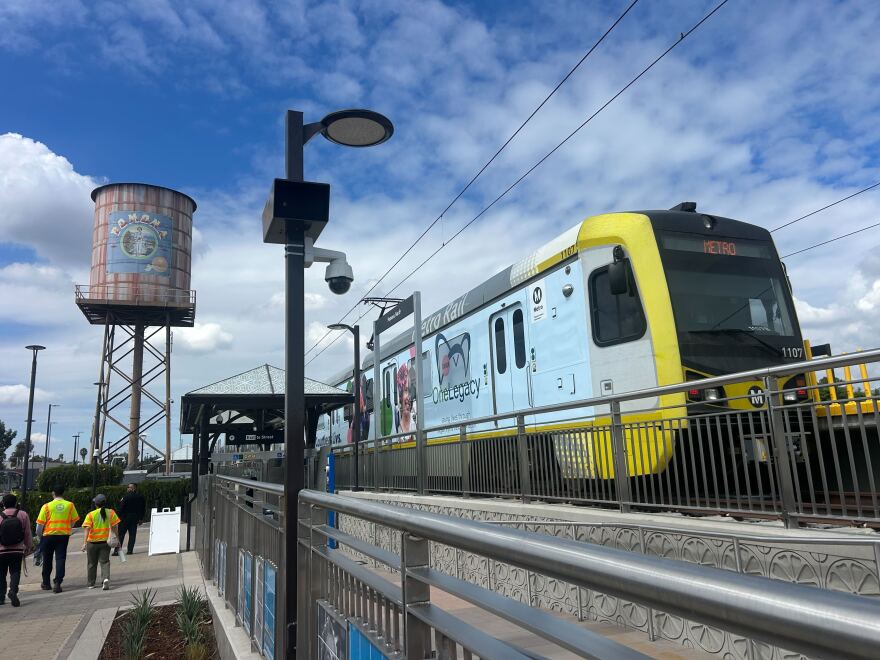Truth matters. Community matters. Your support makes both possible. LAist is one of the few places where news remains independent and free from political and corporate influence. Stand up for truth and for LAist. Make your year-end tax-deductible gift now.
Metro’s A Line is long. It’s about to get longer with new stops opening in San Gabriel Valley

Four new A Line stations in the San Gabriel Valley opened to the public on Friday, bringing the total length of the light rail to nearly 60 miles as it now extends into Pomona.
The extension brings the line to within just a few miles of the original goal of building out to Montclair, which wasn’t possible due to budget shortfalls and might never come to fruition after the county-level body overseeing transportation in San Bernardino decided earlier this month not to support the project.
Still, Habib Balian, the CEO of the Foothill Gold Line Construction Authority, which has overseen the expansion of the A-line, said the $1.5 billion extension to Pomona has been a long time coming.
“It's probably 20 years overdue,” Balian told LAist. “But we're happy to bring it into fruition at this point.”
Metro’s CEO, Stephanie Wiggins, called the extension a major accomplishment.
“An executive heading to her job downtown, a student on the way to class, or a family going to a Dodgers game, Metro serves all of us,” Wiggins said. “We are part of shared communities, and those communities are interconnected here in the San Gabriel Valley.”
What to know about the extension
The new stations are located in Glendora, San Dimas, La Verne and Pomona. The addition brings the total number of stations on the A Line to 48.
The north-south segment of the train runs from Long Beach through downtown, Northeast L.A. and Pasadena. The four new stations extend the eastern segment, moving the terminus from Azusa to Pomona.
The Glendora, San Dimas and Pomona stations connect with the Foothill Transit bus network. You can also catch the San Bernardino Metrolink at the Pomona station.
There will be more trains running along the A Line now that it’s extended, according to Balian.
Metro says trains will run every 8 minutes during peak weekday hours. During off-peak weekday and daytime weekend hours, trains will run every 10 minutes. In the later hours, the frequency dips to a train every 20 minutes.
Metro estimates a trip from Union Station in downtown L.A. to Pomona will take just over an hour.
The A Line is one of the most popular L.A. Metro rail lines with around 1.8 million boardings per month since the beginning of last year.

The significance of the extension
There are 19 college campuses along the route from Azusa to Pomona.
“This particular line is sometimes called the brain train,” Ed Reece, chairman of the construction authority board, said.
Lucas LeVieux, an urban planning student at Cal Poly Pomona, said the A Line extension will be a “game-changer” that will help the school progress toward its climate and enrollment goals.
"Cal Poly Pomona students are really thirsty for quality public transit on campus,” said LeVieux, who serves as a student representative on the university’s Alternative Transportation Committee. “Even with over 14,000 parking spots, I hear students constantly complain about parking availability — to say nothing of the congestion, cost, safety risk and environmental impact of all those cars.”
University of La Verne President Risa Dickson said the expanded Metro rail opens more opportunities for students. Students at junior colleges, for example, need access to housing, she said.
“If they can get on a line at one place and get off at our campus, they can live in our dorms at a much lower rate it will cost them to rent in the community,” Dickson said. “It also enables them to have access to the dining services, have access to the campus community, and it makes it much easier for them to think about their future in a four-year degree format.”
Given the breadth of areas the A Line serves, Reece said the four new stations will help with mobility during the 2028 L.A. Olympics.
“There's very much an opportunity for riders, enthusiasts [and] visitors to jump on and be able to attend some of these events at some of these venues,” he said.
The L.A. County Fairplex, where the annual fair is held and where cricket will be played during the 2028 Games, is a short distance from the new La Verne stop.
Five years and $1.5 billion later
The Foothill Gold Line Construction Authority has overseen the planning, design and construction of A Line extensions since the state created the independent agency in 1998.
The A Line was formerly known as the Gold Line, hence the name of the agency.
The independent agency began major construction on the 9.1 mile-long extension in 2020. It turned the project over to Metro earlier this year for continued testing and future operation.
This extension was originally conceived to include an additional two stations in Claremont and Montclair. But due to budget issues, the plan was changed in 2019 to complete the extension in two phases, with the first bringing the A Line to Pomona.
“It was determined that it was more important to get the project built as far as we could,” Balian said.
The $1.5 billion extension was primarily funded through Measure M, the half-cent sales tax for transportation and mobility projects that L.A. County voters approved in 2016. Unused funding from the Pasadena to Azusa extension, as well as state and local government dollars also supported the project.
Uncertainty for future extension
Whether the train makes it to Montclair is unclear.
The San Bernardino County Transportation Authority announced earlier in September that without a seat on the governing board of the Construction Authority, which would build the project, it was pulling funding from the Montclair extension.
“This decision was not made hastily,” the agency said in a statement. “It comes after nearly a decade of deliberation about the ever-escalating timelines and costs associated with the extension, coupled with the Board’s frustration over the absence of local control in decision-making.”
Balian said the dispute and ensuing decision over the governing structure was “unfortunate.”
“ Although it's worked in every other city along the way over the last 25 miles, it was not something that they were interested in doing or felt comfortable doing,” Balian said.
How to reach me
If you have a tip, you can reach me on Signal. My username is kharjai.61.
- You can follow this link to reach me there or type my username in the search bar after starting a new chat.
- For instructions on getting started with Signal, see the app's support page.
- And if you're comfortable just reaching out my email I'm at kharjai@scpr.org
The agency is still looking to build at least one additional station in Claremont. Balian said the Construction Authority is hoping to award a design contract for that extension in November, followed by a construction contract in two years.
“ In the intervening years, we'll look to San Bernardino to come up with an alternative,” Balian said.
Updated September 19, 2025 at 2:35 PM PDT
This article was updated to include quotes from the A Line's opening day.












